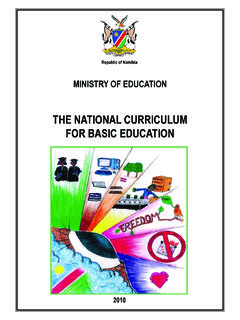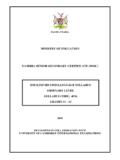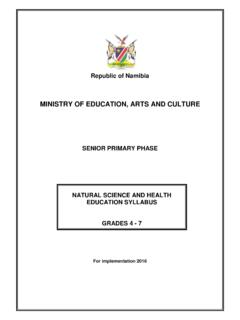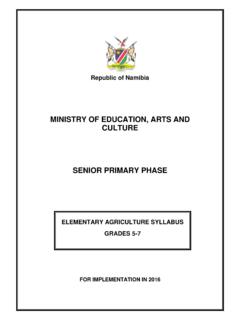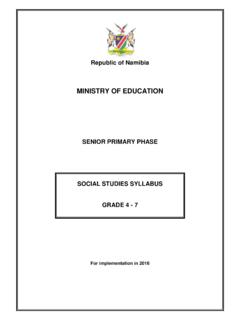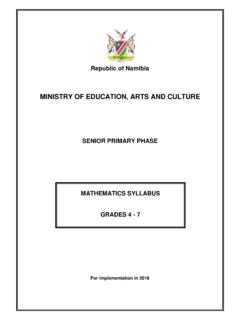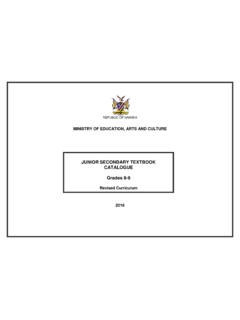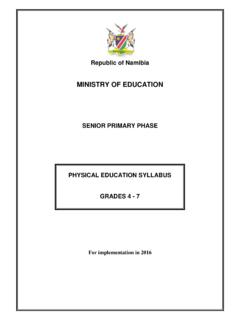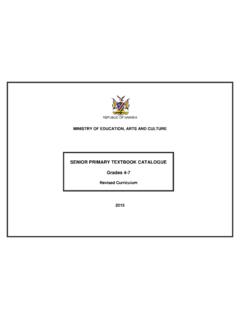Transcription of MINISTRY OF EDUCATION, ARTS AND CULTURE
1 Republic of namibia MINISTRY OF education , ARTS AND CULTURE JUNIOR SECONDARY PHASE For implementation: Grade 8 in 2017 and Grade 9 in 2018 GEOGRAPHY SYLLABUS GRADES 8 & 9 MINISTRY of education , Arts and CULTURE National Institute for Educational Development (NIED) Private Bag 2034 Okahandja namibia Copyright NIED, MINISTRY of education , Arts and CULTURE 2015 Geography Phase Syllabus Grades 8 - 9 ISBN: 978-99945-2-134-0 Printed by NIED Website: Publication date: December 2015 TABLE OF CONTENTS 1. Introduction.
2 1 2. Rationale .. 1 3. Aims .. 1 4. Inclusive education .. 2 5. Links to Other Subjects and Cross-curricular Issues .. 3 6. Approach to teaching and learning .. 5 7. End of Phase Competencies .. 6 8. Summary of the learning content for Grade 8 and 9 .. 7 9. Learning 9 Introduction to learning content .. 9 Learning 9 Learning content for Grade 8 .. 10 Learning content for grade 9 .. 20 10. Assessment .. 32 Continuous Assessment .. 32 Formative and summative assessment .. 32 Informal and formal methods .. 33 Evaluation .. 33 Criterion-referenced grades.
3 33 Grade descriptors .. 35 Conducting and recording assessment .. 36 Assessment objectives .. 36 Continuous assessment: detailed guidelines .. 39 End-of-year examinations: detailed guidelines .. 42 Promotion marks .. 44 Specification grid .. 45 Assessment 45 Annexe 1: Glossary of command terms .. 47 Annexe 2: Glossary terms .. 50 Annexe 3: Assessment record sheet for Grade 8 .. 53 Annexe 4: Assessment record sheet for Grade 9 .. 54 Geography syllabus, Grade 8-9, NIED 2015 1 1. Introduction This syllabus describes the intended learning and assessment for Geography in Grade 8-9.
4 As a subject, Geography is within the social and economic area of learning in the curriculum, but has thematic links to other subjects across the curriculum. Participation in the social, civic, political, economic, cultural and natural environment is central to this area of learning. It includes understanding and interpreting past events and present human behavior and experience, and how they influence events, circumstances and the environment. The aims, learning objectives, and basic competencies which overlap subjects are amongst the essential learning within the curriculum as a whole. Under ideal conditions, the Geography syllabi for Grades 8-9 would require 3 periods per week.
5 2. Rationale Geography is the study of earth s landscapes, people, places and environment. It examines humans in their interdependent relationship with the earth. Geography is unique in bridging the social sciences (human geography) with natural sciences (physical geography). Human geography concerns the understanding of the dynamics of cultures, societies and economies, while physical geography concerns the understanding of the dynamics of physical landscape and the environment. It helps us all to be more socially and environmentally sensitive, informed and responsible citizens.
6 Geography provides scientific knowledge about physical, environmental and human processes which form the basis for cross-curricular education . Geography promotes the following aims in the curriculum guide: intellectual development, personal development and self-fulfillment, social and cultural development and development of environmental and population awareness 3. Aims Geography promotes the following aims in the curriculum: Knowledge with understanding of: the terminology, concepts and systems fundamental to a study of physical and human Geography the relationships and interactions of people and their environment in response to physical and human processes, as well as aspects of the changing world Geography syllabus, Grade 8-9, NIED 2015 2 a sense of place and relative location on a local, regional and global scale, with special emphasis on namibia examples HIV and AIDS and its impact on socio-economic development An awareness.
7 Of the characteristics and distribution of a selection of physical and human environments that on earth and also in our country there are different ways of life, and this encourage positive attitude towards diversity of the factors that cause change in the diverse environment and sensitivity to gender issues An appreciation of: the potentials and limitations of the physical environment for human activities how human activities can lead to environmental problems and improvements the environment and the need for conservation Geographical skills: use suitable techniques for observing, collecting, classifying, presenting, analysing and interpreting data obtain information from a variety of sources such as, maps of various scales, internet, documentary materials and statistics make informed judgements and decisions 4.
8 Inclusive education Inclusive education is the right of every learner and promotes access to and participation in the full range of educational programmes and services offered by the education system in mainstream schools. It is based on the principle of supporting and celebrating the diversity found among all learners and removing all barriers to learning. The Geography teacher in the Junior Secondary Phase should therefore accommodate learners with special educational needs by adapting this syllabus to the needs of the learner through differentiation of teaching methods and material as indicated in the Curriculum Framework for Inclusive education : A Supplement to the National Curriculum for Basic education (2014).
9 The adaptation for assessment of learners with special educational needs must be done as prescribed in the Handbook for Centres (2014) by the Directorate of National Examinations and Assessment (DNEA). The accommodations Geography syllabus, Grade 8-9, NIED 2015 3 prescribed in this handbook are not only for external examinations, but apply to learners from Grade 1 to 12. Learners who are so severely impaired that they cannot benefit from attending mainstream schools will be provided for according to their needs in learning support units, resource units or resource schools until such time that they can join a mainstream school structure, if possible.
10 In resource based teaching, teachers are urged to adapt their local or available learning support materials to achieve gender neutrality (texts, pictures, cartoons etc.). In cases of assessments, teachers (including examiners and moderators) are urged to ensure that questions and resources promote gender equity. 5. Links to Other Subjects and Cross-curricular Issues The cross-curricular issues include Environmental Learning; HIV and AIDS; Population education ; education for Human Rights and Democracy (EHRD), Information and Communication Technology (ICT) and Road Safety.
